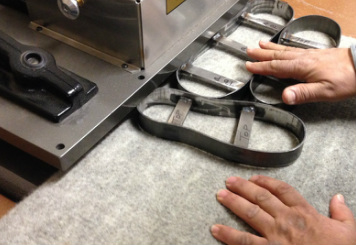The Mill Process
So, if you have fibre to be processed, whether it be alpaca, sheep or other, you may have wondered what the fibre mill process looks like.
Our equipment is designed for custom processing and has larger capacity than cottage industry or mini-mill equipment, meaning our throughput speed to finished product is faster.
When your fibre arrives at the mill it is weighed, logged in and assessed for final desired product.
Our equipment is designed for custom processing and has larger capacity than cottage industry or mini-mill equipment, meaning our throughput speed to finished product is faster.
When your fibre arrives at the mill it is weighed, logged in and assessed for final desired product.
|
Picking the fibre is the next step in the process. This opens and separates the locks of the fleece in preparation for carding. This is the first stage in the process where fibre can be blended. Blending at the picker is useful if you are combining multiple fleeces and want absolute consistency in the end product. |
|
The carder could be called the heart of the mill operation. It is at the carder where the cloud of picked fibres is aligned into either batts for felting or duvets, or roving for spinning into yarn. Our carder has multiple rolls, each covered with specialized blades to comb the fibre into alignment. No need to pay additional costs for dehairing as our carder dehairs fibre as part of the process. The carder blades are very effective in helping to remove leftover 2nd cuts, guard hair and vegetation, but it doesn't mean that skirting is not required. Remember if you don't want to see it in your final product, all of the above should be removed during skirting, prior to sending the fibre to the mill. The fibre leaves the carder as a consistent web and then either collects on a drum as a batt or is funnelled through the roving deck for later spinning. If your request is for fleece batts or roving for handspinning, the process is complete except for packaging and shipping. If you wanted your batts made into felt, they are carefully transported to the needlefelter for continued processing. |

We're now able to make insoles from the coarsest, most inconsistent fibres. No need to keep different colours, grades or lengths separate during skirting. Combine your neck or blanket fibres together, the coarser the better. We combine an equal amount of local sheep fleece and after making a very thick felt sheet, stamp small, medium, large or X-large insoles using die cutters and a press.
|
Roving to be made into spun yarn continues in the process to the Pindrafter for further alignment. As our mill is a semi-worsted mill, this is an integral step prior to spinning. Multiple streams of roving are pindrafted through a series of extremely sharp combs multiple times until the top is consistent and ready for spinning. Rovings of different fibres can be blended at this stage. |
|
Once the roving, now top, is consistent and the correct weight, it is ready to be spun into a single ply yarn on the spinner. A determination of the final yarn weight and twist is made based on the fineness of the fibre. Generally the finer the fibre, the lighter the yarn weight. The final yarn will be spun based on multiple plys either 2, 3, 4 or more. The yarn is balanced during plying to ensure it is neither over twisted or under-twisted. Balanced yarn is required so the final knit product hangs evenly. |
|
The final stages of yarn processing are measuring the finished yarn into skeins or winding onto cones. We can do either, based on your preference.
If the yarn is measured into skeins, we finish it with a final handwash to remove all the conditioners used during the process, brightening and fulling the fibres into its beautiful natural state, ready for you to label and sell. |












